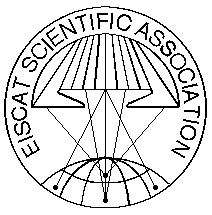
November 28 - December 02, 2011 - Namur, Belgium
Posters session 4B
Space Weather Effects on the Earth's Thermosphere, Ionosphere and Plasmasphere
| Session: | Posters Session 4B (13) |
| Type: | |
| Date: | Thursday, December 01, 2011 |
| Time: | 10:30 - 11:15 |
| Chair: | Michael Danielides & Ioanna Tsagouri |
| Co-chair: | |
| Remarks: |
| Seq | Time | Title | Abs No | ||||
| 1 | 00:00 |
Space Weather Effects on the Plasmasphere: Links with the Ionosphere and Radiation Belts
Pierrard, Viviane1; Darrouzet, Fabien1; Borremans, Kris1; Cabrera, Juan2 1Belgian Institute for Space Aeronomy, BELGIUM; 2UniversitÈ Catholique de Louvain, BELGIUM
The plasmasphere is a very dynamic region. This dynamics is mainly determined by the convection electric field due to the influence of the solar wind, combined with the corotation electric field. The plasmasphere is disturbed during geomagnetic storms and substorms, with formation of a sharp plasmapause closer to the Earth and generation of a plume in the afternoon MLT sector. |
|||||
| 2 | 00:00 |
Two types of positive Disturbances in the Daytime mid-latitude F2-Layer: Morphology and Formation Mechanism
Mikhailov, Andrey1; Perrone, Loredana2; Smirnova, N3 1IZMIRAN, RUSSIAN FEDERATION; 2INGV, ITALY; 3IDG RAS, RUSSIAN FEDERATION
Morphological analysis of foF2 variations for the periods of daytime positive disturbances over three ionospheric stations - located in sub-auroral zone, middle latitudes, and middle-low latitudes- has confirmed the existence of two types of positive F2-layer disturbances with different morphology. |
|||||
| 3 | 00:00 |
Space Weather Effects in the Earth's Winter lower Atmosphere
Bochnicek, Josef1; Davidkovova, Hana1; Hejda, Pavel1; Huth, Radan2 1Institute of Geophysics of the AS CR, CZECH REPUBLIC; 2Institute of Atmospheric Physics of the AS CR, CZECH REPUBLIC The paper describes the association between high long-lasting solar/geomagnetic activity and pressure-distribution changes in the winter lower atmosphere, based on their development in the Northern Hemisphere winter periods (DecemberñMarch) in 1951-2003. Solar/geomagnetic activity is characterized by 30-day mean of R number and/or by 30-day mean of daily sum of Kp index. Lower atmosphere pressure distributions are described by 30-day mean anomalies using the long-term daily average in geopotential height (GPH) at 50 hPa/500 hPa. The evaluations of 30-day mean values of solar/geomagnetic activity and pressure anomalies were made with five-day step through the whole winter period. Analysis was made using composite maps which represent the distribution of GPH anomalies during high (R≥90) solar activity and high (sum Kp≥19) geomagnetic activity. Composite maps made according to solar activity show significant pressure decrease in the stratospheric polar region in December, positive phase of the North Atlantic Oscillation (NAO) in February and March, and appearance of positive pressure anomalies in the eastern region of the Aleutian low in the middle of February. Composite maps made according to geomagnetic activity indicate noticeable impact of atmospheric data from the fifties on the distribution of stratospheric and tropospheric GPH anomalies. Composite maps in which those data are omitted show close relationship between high long-lasting geomagnetic activity and significant pressure decrease in the stratospheric polar region and distinct positive NAO phase during the whole investigated winter period. Statistical significance was evaluated using The Monte Carlo method. |
|||||
| 4 | 00:00 |
The Ionospheric Effects of Solar Eclipse on January 4, 2011 over Europe using Multiinstrumental Observations
Shagimuratov, Irk1; Cherniak, Iurii1; Krankowski, Andrzej2; Korenkova, Nina1; Tepenitsina, Nadezhda1 1West Department of IZMIRAN, RUSSIAN FEDERATION; 2Geodynamics Research Laboratory, University of Warmia and Mazury, POLAND The in the mid-latitude ionosphere that was accompanied with the solar eclipse 4 January 2011 is considered. To observe the eclipse ionospheric changes different techniques have been used. It was analyzed the observations of ionosphere were carried out with Kaliningrad, Moscow and Juliusruh ionosondes. The eclipse over observation points took place at aftersunrise hours in quiet geomagnetic conditions. For analyzing of the spatial and temporal changes of the ionosphere over Europe was used the GNSS network data. The negative variation of foF2 values and TEC distribution was clearly observed. The maximum ionospheric effect of the solar eclipse was observed over Kaliningrad ionosonde from 7.17 till 10.05 UT. The maximal phase of eclipse for Kaliningrad was registered at 8.39 with the coefficient of solar disk covering of about 76.94%. For this observation point the foF2 decrease up to 1.6 times registered with delay about 10 min relative to maximum eclipse phase. The effect of the eclipse also was detected in diurnal variations and in the variations of TEC along individual satellite passes. The two-dimensional TEC maps constructed with high-time resolution (5-minute interval) show that the eclipse produced remarkable changes in the structure of the ionosphere. These TEC maps demonstrate also that the depression of TEC reached about 30% compared to a control day. It was carried out the comparison analysis with processes accompanied with October 4, 2005 solar eclipse. The observation results are adduced. |
|||||
| 5 | 00:00 |
Response of the mid-latitude Ionosphere to Geomagnetic Storm on October 11, 2008
Zakharenkova, Irina1; Krypiak-Gregorczyk, Anna2; Shagimuratov, Irk1; Krankowski, Andrzej2 1West Department of IZMIRAN, RUSSIAN FEDERATION; 2Geodynamics Research Laboratory, University of Warmia and Mazury, POLAND The ionosphere behavior during moderate geomagnetic disturbance which occurred on October 11, 2008 was analyzed. This disturbance occurred during a period of very low solar activity. A relatively weak but isolated geomagnetic disturbance was characterized by the well-pronounced positive effect observed in the ionosphere at the dayside. The short-duration positive effect was revealed distinctly in GPS TEC and ionosondes' measurements. The strong TEC increase over European region has rather short duration (11-15 UT) and its amplitude reached the maximum value of 9 TECU (100% relative to the quiet conditions). This enhancement was clearly observed in the foF2 variations over ionosonde stations Juliusruh, Pruhonice and Rome. The foF2 increased from 5.6 to 9.0 MHz during the 3 h period at Juliusruh and from 5.6 to 8.3 MHz during the 3 h period at Rome. The electron density profiles retrieved from the COSMIC radio occultation measurements were analyzed and their validity was tested by comparison with ground-based measurements. This positive effect was revealed distinctly in COSMIC RO electron density profiles and products based on these data - ionospheric electron content and global maps of electron density. |
|||||
| 6 | 00:00 |
Empirical Model Describing Propagation Characteristics of Whistler Waves in the Earth Radiation Belts
Agapitov, Oleksiy1; Krasnoselskikh, Vladimir2; Rolland, Guy3 1LPCEE, Orleans/National University of Kyiv, FRANCE; 2LPCEE, Orleans, FRANCE; 3CNES, Toulouse, France, FRANCE We performed a statistical study and constructed the probability distribution of wave amplitudes and wave normal vectors making use of the wave measurements on board Cluster satellites during nine years 2001-2009. This statistical database covers the regions of the magnetosphere frequently visited by Cluster satellites, L-shells from 2 to 7, at different local times and on different magnetic latitudes for quiet, moderate and active magnetosphere activity. The analysis is performed in the frequency range from 8.8 Hz up to 3.56 kHz making use of the STAFF-SA instrument measurements. The results can be summarized as follows: The most intensive chorus waves are observed in the range from 23 to 13 hours MLT and at L-shells from 2 to 3 and from 4 to 6 which is consistent with previous studies. Statistical characteristics of distributions are different for low and moderate magnetospheric activity conditions (Kp < 5) and high magnetospheric activity conditions (Kp > 5). There are two well distinguishable regions where statistical properties of wave amplitudes and normal vector distributions exhibit different statistical characteristics under low and moderate activity conditions: 1) L = 2-4 (up to plasmapause) where lightning generated and magnetospheric chorus generated whistlers are supposed to dominate; 2) the region where the chorus type whistlers dominate, L = 4-6.5. The magnetic latitudinal dependence of the wave normal vectors distribution obtained for the first time clearly shows the increase of the maximum of the distribution from about 20° at equator up to 80° at about 30° magnetic latitude. The probability distribution of wave activity parameters are usually non-symmetric and have significant non-Gaussian tails, thus one can suggest that they cannot be well-described by long-term time averages. The results obtained can have important consequences for the description of the diffusion process of wave-particle interaction. The conventional averaging procedures cannot be performed without taking into account relatively rapid departure of wave normal vectors from quasi-parallel propagation conditions, thus they should take into account more realistic wave energy and k-vector distributions. We present the analytical mapping of the probability distribution function of the wave-vector directions which allows to restore the VLF wave distribution in the inner magnetosphere by analytical approximation with small number of parameters: particularly the mean values of the angle between wave normal and the background magnetic field and the amplitude distributions for each magnetic latitude and magnetic local time. |
|||||
| 7 | 00:00 |
Effects of Severe Magnetic Storms in the Upper Atmosphere over Kharkiv
Lyashenko, Mykhaylo; Chernogor, Leonid; Domnin, Igor Institute of Ionosphere, UKRAINE
We study the features of well pronounced ionospheric disturbances accompanying severe magnetic storms on 25 September 1998, 29-30 May 2003 and 7-10 November 2004 (Kp ≥ 8) as observed by the Kharkiv incoherent scatter radar (49.6°N, 36.3°E). Among considered features there are depletion in electron density by a factor of 3.5-7, uplifting of ionospheric F2 region by more than 100 km, unusual nighttime heating of plasma up to daytime values of electron and ion temperatures, and infringements of plasma transfer process and of thermal balance in the ionosphere - plasmasphere system. |
|||||
| 8 | 00:00 |
Variations of Ionospheric Plasma Parameters during the Solar Eclipse January 4, 2011 over Kharkiv
Lyashenko, Mykhaylo; Chernogor, Leonid; Domnin, Igor Institute of Ionosphere, UKRAINE
Observation and modeling results of the solar eclipse (SE) on 4 January 2011 effects in geospace plasma parameters variations are presented. |
|||||
| 9 | 00:00 |
A Model for the Short-Time Forecast of Relativistic Electrons at Geosynchronous Orbit
Potapov, Alexander1; Degtyarev, Vitaly I.1; Tsegmed, Battuulai2; Kharchenko , Irina P.1 1Institute of Solar-Terrestrial Physics SB RAS, RUSSIAN FEDERATION; 2Research Center for Astronomy and Geophysics MAS, MONGOLIA On March 13, 2009 high speed stream from a coronal hole reached the Earth causing a slight disturbance (Dstmin = -28 nT). ULF waves with the frequency between 3 and 4 mHz have been delivered to the magnetosphere together with the solar plasma. Oscillations of the same frequency were clearly seen by GOES magnetometers at the geosynchronous orbit, and by ground based magnetometers globally, both at auroral and medium latitudes. This evidences for direct penetration of the ULF waves from the solar wind into the magnetosphere. Following a sharp drop in the electron fluxes early on March 13 their growth began on March 13-15. Moderate energy (E > 0.6 Mev) electron flux increased faster. Peak of the relativistic (E > 2 MeV) electrons was reached late on March 15. On the first day the effectiveness of the moderate energy electron acceleration by the ULF waves was high due to high activity of the oscillations in the magnetosphere. The relativistic electron fluxes (E > 2 MeV), however, did not increase as fast as that because a number of the "seed" electrons of moderate energy is not so high. On the second day of the disturbance a number of the moderate energy particles is sufficient to fast increase of relativistic electron fluxes even under the reduced wave activity. The event described is a typical example of a sequence of processes that cause enhancement of killer electron fluxes. Basing on understanding of this processes we tried to construct a model for relativistic electron flux forecast. On the ground, an indicator of presence of moderate energy electrons is activity of PiB geomagnetic pulsations. On the other hand, global ULF oscillations of Pc5 type are the source of energy for electron acceleration up to relativistic velocities, so they can serve as an indicator of the acceleration process. Combining information about these two types of pulsations we propose a model which can predict fluxes of relativistic electrons. For 22 events analyzed a comparison of predicted flux of E > 2 MeV electrons at geosynchronous orbit with measured flux gave correlation coefficient of 0.86. |
|||||
| 10 | 00:00 |
Reality and Occurrence Frequency of high Historical Values of foEs
Lastovicka, Jan; Boska, Josef Institute of Atmospheric Physics ASCR, CZECH REPUBLIC Very high values of foEs had sometimes been reported in the past. These values, as well as all other ionogram-scaled values, had been derived from ionograms under the assumption of the vertical reflection of ordinary mode of sounding radio waves. In the past it was impossible to check validity of this assumption. However, modern digisondes determine clearly the oblique or extraordinary mode reflections. To test the assumption of the vertical reflection of ordinary mode for high values of foEs, seven summers (June-August 2004-2010) from a midlatitude station Pruhonice are chosen. All hourly values of foEs higher than 6.0 MHz are selected from this data set, altogether 282 values. In 90% of cases the classical way of evaluation of foEs provides values higher than true values from modern digisonde (average difference about 1 MHz). 38% of classical foEs are oblique reflections, which however do not occur in directions perpendicular to geomagnetic field. The occurrence of high values of foEs varies very much from year to year between 0-130 events per year. As for diurnal variation, a pronounced maximum occurs at ~10:00 LT and 16:00 LT (secondary), and a minimum after midnight. |
|||||
| 11 | 00:00 |
Influence of Non-vetrical Echoes to Ionogram Interpretation
Kouba, Daniel; Koucka Knizova (Sauli), Petra IAP AS CR, CZECH REPUBLIC Regular vertical ionospheric sounding is basically provided by two sounding systems. Main difference consists in the receiving antenna field that records reflected signal from ionospheric plasma. While the classical ionosonds recod only time of flight of the reflected electromagnetic signal the DPS 4 digisonde measures also other properties of the electromagnetic signals reflected from ionosphere (time of flight, wave polarization, amplitude, phase, angle of arrival etc.). The DPS 4 digisonde provides automatic scaling of ionograms as well in order to obtain additional information about ionospheric plasma motion. Here, we demonstrate scaling and ionogram interpretation recorded by DPS 4 digisonde and olde ionosonde equipment used in Pruhonice observatory. We demonstrate cases where the interpretation of ionograms is complicated and may lead to the serious errors. We have collected the representative data set to demonstrate the differences in scaling when complicated ionospheric situations like triple splitting, spread F, irregularities on the ionospheric electron density profile shape, presence of Sporadic E layer etc. occur. |
|||||
| 12 | 00:00 |
Modeling and Measuring Variation of Auroral Electrojet Latitude during Magnetic Storms.
Leer, Kristoffer1; Vennerstrom, Susanne1; Rast‰tter, Lutz2; Ridley, Aaron3; Raeder, Jimmy4 1DTU-Space, DENMARK; 2NASA/Goddard Space Flight Center, UNITED STATES; 3University of Michigan, UNITED STATES; 4University of New Hampshire , UNITED KINGDOM The auroral electrojets are interesting in a space weather context mainly due to their ability to produce geomagnetically induced currents (GICs) at high and mid-latitudes. The capability to simulate the position of the auroral electrojets in the ionosphere has been tested for three MHD models (OpenGGCM, BATSRUS and BATSRUS with RCM) using The Community Coordinated Modeling Center (CCMC) implementation of these models. A method has been developed to estimate the latitude and intensity of the electrojets based on magnetic measurements from LEO polar orbiting spacecraft. The position (latitude) of the maximum current from model data and from magnetic data has thus been compared for the three models. Hence the models' ability to simulate auroral electrojet location and intensity during magnetic storms has been tested. |
|||||
| 13 | 00:00 |
The ionospheric Fluctuations Activity in GPS TEC Measurements observed at northern Hemisphere during Solar Minimum
Cherniak, Iurii1; Sieradzki, Rafal2; Krankowski, Andrzej2; Shagimuratov, Irk1; Zakharenkova, Irina1 1West Department of IZMIRAN, RUSSIAN FEDERATION; 2University of Warmia and Mazury in Olsztyn, Geodynamics Research Laboratory, POLAND
The increasing number of permanent GNSS stations allows to use the GPS-derived total electron content (TEC) observations to detect the ionospheric disturbances with high spatial and temporal resolution. The most intensive phase fluctuations are observed at the high latitude, equatorial and strong disturbed midlatitude ionosphere. At the quite conditions the midlatitude fluctuations are rather weak. But all these events can influence on the performance and precision of navigation parameters' determination. 1. Shagimuratov I.I., Krankowski A., Ephishov I., Zakharenkova I., Tepenitsyna N., 2009, Occurrence of GPS Phase Fluctuations in Northen andSouthern Hemisphere, Proceedings of 20th International Symposium on Electromagnetic Compatibility. Zurich, Switzerland, 12-16 January 2009, pp. 305-308. |
|||||
| 14 | 00:00 |
Development of new Cosmic Ray Ionization Model for the Atmosphere (CRIMA) with Account to 4- Characteristic Intervals
Velinov, Peter; Mateev, Lachezar; Asenovski, Simeon Institute for Space and Solar-Terrestrial Research, BULGARIA Introduction. We improve our previous Cosmic Ray (CR) ionization rate model because it is important for investigation of the different space weather effects. The cosmic rays and XUV radiation determine to a great extent the chemistry and electrical parameters in the middle and upper atmosphere, where are situated strato-mesosphere and thermosphere. They create ozonosphere and influence actively the stratosphere ozone processes. But the ozonosphere controls the meteorological solar constant and the thermal regime and dynamics of the lower atmosphere, i.e. the weather and climate processes. CR influence dominates during the night and sunrise-sunset periods, because galactic CR are always bombarding the Earth atmosphere. The CR flux varies during the solar cycle in an opposite face to that of sunspots. This hypothesis of the solar-terrestrial relationships shows the way to a non-contradictory solution of the key problems of the solar-terrestrial physics. Model description. The presented new version Cosmic Ray Ionization Model for the Atmosphere (CRIMA) is physical space weather model with fully operational implementations. CRIMA is able to produce values of electron production rates q(h) due to CR ionization in the Earth atmosphere for different altitudes (30 ñ 120 km), solar and geomagnetic activities (low, moderate and high), and atmospheric cut offs. Besides, CRIMA can determine the energy interval contributions for all groups of CR nuclei. The effects of galactic and solar cosmic rays (CR) in the middle atmosphere can be computed with our model. We take into account the CR modulation by solar wind. In fact, CRs determine the electric conductivity in the middle atmosphere and influence the electric processes in it. In this way CRs introduce the solar variability in the terrestrial atmosphere and ozonosphere. Results. A new analytical approach for CR ionization by protons and nuclei with charge Z in the lower ionosphere and the middle atmosphere is developed. For this purpose, the ionization losses (dE/dh) for the energetic charged particles according to the Bohr-Bethe-Bloch formula are approximated in different energy intervals (three ionization losses intervals, one charge Z decrease interval and three intermediate coupling intervals). On this way we increase the number of the approximation intervals and with this new improvements the model accuracy becomes better. Besides, the real physical process is now described more adequately. For example the charge decrease interval contribution at height of 50 km reaches almost 20% from the corresponding electron production rate value. The intermediate interval contribution at 35 km is about 10%. So these new interval calculations may be important for the model results. Solution methods. Electron production rate profiles q(h) are determined by the numerical evaluation of a 3D integral with account of cut-off rigidities. The integrand in q(h) gives the possibility for application of adequate numerical methods - in this case Wolfram Mathematica 7 and Maple 14 interactive procedures, for the solution of the mathematical problem. The contributions of the different approximation energy intervals can be presented in graphical mode. In this way the process of interaction of CR particles with the upper and middle atmosphere are described much more realistically. The full CR composition is taken into account. The COSPAR International Reference Atmosphere CIRA'86 is applied in the computer program for the neutral air density and scale height values. Conclusion. The structure of the proposed CRIMA model allows its decomposition in several submodels. In this case we take into account the physical meaning of the independent variables subintervals. The ionization losses function is calculated taking into account the energetic particles charge decrease interval. The energy interval investigation takes place according to the goal of the user of the model with respect to accuracy and interval types. The proposed improved CRIMA model will contribute to the quantitative understanding of solar-atmosphere relationships. REFERENCES Velinov, P.I.Y., Dorman, L., Nestorov, G., Cosmic ray influence on the ionosphere and on radiowave propagation. Sofia, BAS Publ., 1974.
|
|||||
| 15 | 00:00 |
Ionospheric Behaviour during Recovery Phase of intense Magnetic Disturbances
Buresova, Dalia; Chum, Jaroslav; Lastovicka, Jan; Sindelarova, Tereza; Chlupacova, Monika; Novotna, Dagmar Institute of Atmospheric Physics AS CR, CZECH REPUBLIC Intensive ionospheric research, numerous multi-instrumental observations and large-scale numerical simulations of ionospheric F region response to magnetic storm-induced disturbances during the last several decades were primarily focused on the storm main phase, in most cases covering only a few hours of the recovery phase following after storm culmination. Ionospheric behaviour during entire recovery phase still belongs to not sufficiently explored and hardly predictable features. In general, the recovery phase is characterized by an abatement of perturbations and a gradual return to the "ground state" of ionosphere. However, observations of stormy ionosphere show significant departures from the climatology also within this phase. This paper deals with the quantitative and qualitative analysis of the ionospheric behaviour during the entire recovery phase of strong-to-severe magnetic storms at middle latitudes for nowadays and future modelling and forecasting purposes. |
|||||
| 16 | 00:00 |
Simulation of Influence of Trans-Polar Ionospheric Potentia to Characteristics of global Atmospheric Electric Circuit
Tonev, Peter; Velinov, Peter Institute for Space and Solar-Terrestrial Research, BULGARIA
Introduction.The role is studied of the non-uniform distribution of ionospheric potential VP in each polar cap, characterized by a large trans-polar dawn-dusk electric potential difference ΔVP=30-160 kV, in formation of characteristics of the global atmospheric electrical circuit (GAEC) in the atmospheric region 0-100 km. The potential VP is controlled by the solar wind (SW) parameters through field-aligned currents (FAC). It is superimposed to the uniform ionospheric potential VI=250-300 kV. The influence of VP on GAEC is significant due to the large horizontal dimension of potential VP region (more than 3000 km by increased geomagnetic activity) and comparability of ΔVP and VI. Experimental [1] and theoretical studies show that at surface at polar latitudes the fair-weather air-earth electric current jFW can be substantially modified by current jP generated by the superimposed ionospheric potential VP. This type of influence of GAEC by SW can possibly represent a link between the space weather and climate [2]. Our goal is to study in detail the response of GAEC to the solar wind characteristics. 3D model for electrical currents and fields. A physical computational 3D steady-state model is proposed to determine the distributions of the electric current jP and related field EP in the region 0-100 km created by the electric potential VP at altitude ZB=160 km at polar geomagnetic (gm) latitudes, and superimposed to the respective characteristics of GAEC [3]. This altitude is above the dynamo-region in which an effective closure of FAC is realized. The continuity equation for jP is solved:
In Eq.(1) ΦP is the potential of EP, [σ] represents the conductivity tensor. Eq.(1) is solved in spherical coordinates in a domain which comprises altitudes 0-160 km and gm co-latitudes iü60°. The distributions of FAC and VP at altitude 160 km are determined for the specified SW parameters from the model of Weimer, and are used as boundary conditions to Eq.(1). Data for anisotropic conductivity above 80 km by conditions specified are obtained from IRI2007. The conductivity below 80 km is obtained with the account of the columnar resistance, the tropospheric conductivity profile and orography, and with respect of possible sources of large conductivity modifications. Eq.(1) is solved numerically in succeeding steps for separate thin (iü0.5 km) height layers at a triangular mesh by gm coordinates. A finite volume method is used by parameters controlled by the ratio between the field-aligned / vertical jPz and the transverse / horizontal jPH components of the superimposed current jP. Results and analysis. We evaluate the modifications of the electric characteristics of GAEC as function of the SW parameters. First, the vertical superimposed electric current jPz at altitudes below 100 km is studied by a representative set of variations of SW parameters and conditions of conductivity formation, and is compared to the fair-weather current jFW supported by tropospheric electrical sources. At the surface at polar latitudes jPz can reach few tens of percent of jFW. By negative Bz component of IMF it significantly influences jPz, and the total air-earth current varies with the SW parameters. Computational results for the electric current jPz and field EPz are obtained in the mesosphere and lower ionosphere: they can have there a large range of variations, mainly due to the conductivity features. Further the problem is studied whether there are specific conditions by which the superimposed electric field EPz in the mesosphere can reach the order of 1 V/m of magnitude. Such large electric fields depending on the geomagnetic activity have been systematically observed in the polar mesosphere [4]. These fields can have an important role [5] by causing significant electron heating, change of the electron density and the chemical balance. REFERENCES 1. Corney, R., et al. (2003), JASTP 65, 345.
|
|||||
| 17 | 00:00 |
Geomagnetic Activity and altitudinal Decay of Polar orbiting LEO Spacecraft
Vennerstrom, Susanne1; Christiansen, Freddy1; Moretto, Therese2 1DTU-Space, Technical University of Denmark, DENMARK; 2National Science Foundation, UNITED STATES We have evaluated different existing geomagnetic proxies for atmospheric Joule heating concerning their ability to reproduce the rate of altitudinal decay of low altitude polar orbiting spacecraft. We present results concerning altitude variations of the CHAMP satellite on variations of time scales of days and longer for a set of selected periods. We find that the Joule heating contributes significantly to the altitude loss rate, particularly during periods of low solar activity and/or during large geomagnetic storms. Using a simple linear multiregression to separate the effect of UV-radiation and geomagnetic activity provide a nice fit when using either the Knipp 2004 Joule Heating proxy based on the geomagnetic indices PC and Dst or by using Ap directly as Joule heating proxy. The fit is poorer when AE and Kp are used, particularly for the very large events in 2003. We also present a new method to evaluate the Joule heating based on inversion of CHAMP and/or Orsted magnetic observations to estimate polar region currents. |
|||||
| 18 | 00:00 |
New Ionospheric Models for Monitoring and Forecasting Ionospheric Weather
Jakowski, Norbert1; Hoque, Mohammed Mainul2; Wilken, Volker2; Gerzen, Tatjana2; Borries, Claudia2; Missling, Klaus-Dieter3; Barkmann, Henrike3; Tegler, Mirco3 1German Aerospace Center, GERMANY; 2Institute of Communications and Navigation/German Aerospace Center, GERMANY; 3Earth Observation Center/German Aerospace Center, GERMANY
The ionospheric plasma may cause range errors of up to 100m at L-band signals used in Global Navigation Satellite Systems (GNSS). Hence, correction of ionospheric propagation errors is an important task for single frequency users and related augmentation systems such as WAAS in US and EGNOS in Europe. In a first order approximation the range error is proportional to the integral of the electron density along the ray path (Total Electron Content - TEC). Therefore, knowledge of the ionospheric TEC can effectively be used to correct ionospheric errors. |
|||||
| 19 | 00:00 |
Distortions of GNSS Signals as a Result of Space Weather Impacts at high Latitudes
Danielides, Michael1; Rietveld, Mike2; Jakowski, Norbert1 1German Aerospace Center (DLR), GERMANY; 2EISCAT Scientific Association, NORWAY Space weather impacts related to particle precipitations are common and first are impacting Earths upper atmosphere at high latitudes. There trans-ionospheric radio signals from the sparsely distributed global navigation satellite system are frequently disturbed. The aim of this presentation is to discuss high latitude ionospheric radio disturbance phenomena seen in GNSS signals caused both by artificial and natural ionospheric heating. Artificial ionospheric heating can be obtained by induced and controlled electron temperature increase, which leads to localized and temporal disturbances. This can be produced by the EISCAT heating facility. First investigations using a 2D 3 fluid model were showing that similar to natural heating and ionization, a variation of TEC of the order of some tenth of a TEC Unit can be expected from F-region artificial heating. The use of artificial HF heating provides the opportunity of conducting a controlled experiment for TEC variation. The result of a controlled input causing an ionospheric response, in terms of plasma density, electron/ion temperature and vertical ion velocity, is measured. Stronger space weather impacts are seen in TEC variations due to natural heating caused by, e.g., the aurora phenomena. During active geomagnetic conditions and aurora displays TEC variations can be derived from the GNSS measurements of the order of several TEC units. The present study reports on GEISHA 2010-2011, which is an ongoing coordinated measurement campaign including several EISCAT heating experiments simultaneously monitored by ISR, ionosondes, all-sky camera and dual frequency signals transmitted by GNSS obtained from two high frequency receiver stations. This systematic ionospheric heating campaign at high latitudes is designed to understand the impact of the ionospheric plasma and its irregularities on GNSS signal propagation. |
|||||
| 20 | 00:00 |
Monitoring of the ionospheric Storm on 10/11 March 2011 and related Impact on the Norwegian positioning Network CPOS
Jakowski, Norbert1; Wilken, Volker1; Borries, Claudia1; Jacobsen, Knut Stanley2; Schaefer, Sebastian2 1Institute of Communications and Navigation/German Aerospace Center, GERMANY; 2Geodetic Institute/Norwegian Mapping Authority, NORWAY
Ionospheric storms have the capability to degrade precise positioning services and affect Safety of Life (SoL) applications of Global Navigation Satellite Systems (GNSS). Thus, near real time detection and forecasting of ionospheric storms might warn users to prevent misinterpretation of data in positioning and avoid hazardous misleading information (HMI) in SoL applications. |
|||||
| 21 | 00:00 |
Relationships between GEO Satellite Anomalies and Space Weather
You, Moonhee; Park, Jae Woo; Jeong, Cheol Oh; Lee, Yong-Min ETRI, KOREA, REPUBLIC OF In World War II, the solar eruption (solar flare) was revealed to make a significant effect to radar systems. The radio disturbance in February 28, 1942 was due to increased cosmic ray during solar maximum. Since such phenomena had been disclosed, many studies were accomplished on solar flare and solar particle event. Now various researches about the effects of solar flare on the spacecrafts, the airplanes flying across the pole, the radar systems, and wireless communication systems are studied. Especially we are interested in the relationship between solar activities and GEO satellite anomalies. In this paper we analyzed the statistical relationship between GEO satellite anomalies and space weather, especially solar protons and relativistic electrons according to the solar activity period. |
|||||
| 22 | 00:00 |
Ionospheric Delay Monitoring for SX5 Project.
Boska, Josef; Kouba, Daniel; Lastovicka, Jan; Mosna, Zbysek; Buresova, Dalia IAP ASCR, CZECH REPUBLIC SX5 is a research project related to precise positioning with the Europen global satellite navigation system Galileo for scientific purposes. It is funded by the European Union. Galileo features one major advantage compared to all existing and modernized systems: The E5 broadband signal which is transmitted with a bandwidth larger than 90 Mhz and a particularly efficient AltBOC signal modulation. This leads to a substantial reduction of multipath errors - normally a major error contributor to GNSS positioning. Hence, precise positioning will be significantly improved even when using code range measurements. Ionospheric delay monitoring is one of three basic aim of the project. The paper deals with inospheric delay correction based on two different algorithms - Klobuchar method and NeQuick model based algorithm. |
|||||
| 23 | 00:00 |
First Look at GOCE-derived thermosphere Density and Wind Measurements
Doornbos, Eelco1; Bruinsma, Sean2; Koppenwallner, Georg3; Fritsche, Bent3; Visser, Pieter1; Van Den IJssel, Jose1; Kern, Michael4 1Delft University of Technology, NETHERLANDS; 2CNES, FRANCE; 3HTG, GERMANY; 4ESA, NETHERLANDS Accelerometers carried by low-Earth orbiters such as GOCE have the ability to provide highly detailed data on thermospheric density and winds. Like its predecessor missions, CHAMP and GRACE, GOCE has not been specifically designed for studies of the thermosphere. Nevertheless, their application in this domain has resulted in density and wind data sets containing information at unprecedented levels of coverage and precision, resulting in many scientific papers. The orbit of GOCE is unique. It is nearly sun-synchronous, and due to its drag free control system, its altitude can be kept fixed for several years, at about 270 km. This leads to sampling characteristics that are ideal for studying the effect of variations in solar and magnetospheric energy input on the thermosphere density and wind. Besides the presentation of the first GOCE-derived density and wind measurements, this poster will describe the GOCE data processing approach, which differs from that of the earlier missions in the special consideration required for both the handling of the thruster accelerations and the aerodynamic modelling. |
|||||
| 24 | 00:00 |
Contribution of Solar Cosmic Ray He, O and Fe Nuclei to Atmospheric Ionization during some major GLEs in Solar Cycle 23
Velinov, Peter1; Mishev, Alexander2 1Institute for Space and Solar-Terrestrial Research, BULGARIA; 2Institute for Nuclear Research and Nuclear Energetics, BULGARIA
Introduction. The extreme solar activity in October - November 2003 produced three Ground Level Events (GLEs) of cosmic rays with onsets occuring on 28 October, 29 October and 2 November 2003. In the present study the ionization rates during the first of these events and also of GLE on 20 January 2005 are obtained. Recent results important for the production of ion pairs in Earth's atmosphere by various primary cosmic ray nuclei are presented. The formalism of ionization capability based on ionization yield function Y is applied. The various primary cosmic ray nuclei are considered as primaries, namely proton, helium, oxygen and iron. The energy of the primary particles is expressed as GeV per nucleon. A normalization of ionization yield function Y for total ionization is carried out as ion pair production per nucleon. Model description. In this work we describe recent physical model for evaluation of cosmic ray induced ionization in the atmosphere and ionosphere. Last simulations carried out with CORSIKA 6.52 code using FLUKA 2006 and QGSJET II hadronic interaction models, precisely the energy deposit of cosmic ray induced air showers, are described. On the basis of computational results the ionization yield function Y and the ion pair production q(h)- profiles in the atmosphere and ionosphere are obtained. The impacts of the different shower components: electromagnetic, muon and hadronic components are estimated. The simulations are carried out with realistic atmospheric model (US Standard Atmosphere), taking into account Earth's curvature and following steep energy spectrum of primary cosmic rays. Results and analyses. The ionization rate profiles in Earthís atmosphere are calculated using energetic spectra of solar proton, helium, oxygen and iron nuclei and corresponding atmospheric cascade simulation. The corresponding solar particle fluxes are obtained as a function of event time profile. The energy deposition of solar particles in the atmosphere is obtained. The atmosphere is divided per 10 g/cm2, which permits good precision. The variation of geomagnetic rigidity cut-offs as function of geographic position is explicitely taken into account. Different profiles of ion production rates q(h) by solar cosmic rays in upper atmosphere are presented. The contribution of the three main components - electromagnetic, muon and hadronic to total ionization is computed. On the basis of the computational results the ionization yield function Y and the ion pair production rates q(h) in the upper atmosphere are obtained. The ionization rates are obtained for different cases following given solar cosmic ray spectrums. The shape of the obtained q(h)- profiles is compared and evaluated. The presented results are widely discussed. Several applications are demonstrated. Conclusion. This study confirms that the solar energetic particles are important for the many effects in the upper, middle and lower atmosphere. Cosmic rays play important role for the determination of the composition, chemistry of minor constituents (ozone, odd nitrogen, odd hydrogen and other) and the electric conductivity in the atmosphere. In this connection the quantitative investigation of solar cosmic ray ionization in the system troposphere - stratosphere is of big interest. A hypothesis of space weather influence on meteorological weather and climate is also discussed.
REFERENCES Velinov P.I.Y., A. Mishev, & L. Mateev. Model for Induced Ionization by Galactic Cosmic Rays in the Earth Atmosphere and Ionosphere.
Mishev A., & P.I.Y. Velinov. Normalized ionization yield function for various nuclei obtained with full Monte Carlo simulations. Mishev A., P.I.Y. Velinov, L. Mateev, & Y. Tassev. Ionization effect of solar protons in the Earth
atmosphere - case study of the 20 January 2005 SEP event. Mishev A., P.I.Y. Velinov, & L. Mateev. Ion production Rate Profiles in the Atmosphere due to Solar Energetic Particles on 28 October 2003 Obtained with CORSIKA 6.52 Simulations.
Velinov P.I.Y., A. Mishev, S. Asenovski, & L. Mateev. New operational models for CR ionization in space physics. |
|||||
| 25 | 00:00 |
F Region Drift Observations over Cyprus
Economou, Lefteris1; Haralambous, Haris2 1Intercollege, CYPRUS; 2Frederick University, CYPRUS This paper presents an analysis of ionospheric drift measurements over Nicosia ionospheric station (geographic coordinates 35N, 33E) in an effort to study ionospheric electrodynamics on a local scale. The data used in the analysis are based on periods of low solar and geomagnetic activity and also during moderate storms that occurred during the recent solar minimum to identify storm-time drift plasma patterns over Cyprus in order to establish the influence of geomagnetic storms on the local ionosphere. |
|||||
| 26 | 00:00 |
EISCAT_3D: A European three-dimensional Imaging Radar for atmospheric and geospace Research
Tjulin, Anders; Turunen, Esa EISCAT Scientific Association, SWEDEN EISCAT_3D is a next generation incoherent scatter radar system that will be built in northern Fenno-Scandinavia. This facility will provide better resolution and higher power than what is available today, combined with volumetric imaging and built-in interferometry capabilities as well as opportunities for continuous measurements. Several scientific areas will benefit from the capacities that EISCAT_3D will accommodate. These include studies of the solar-terrestrial energy input into the upper atmosphere coupling to the middle and lower atmosphere, the non-linear coupling dynamics, natural variability and long-term trends, the solar-terrestrial energy impact on climate change via atmospheric chemistry and electricity, and the development of predictive modelling capabilities. Fundamental space plasma physics research of turbulence, dusty plasmas, wave-plasma interactions, resonances, and plasma irregularities in the ionosphere will also be strengthened, and extended with the possibility to explore applications using the orbital angular momentum of the electromagnetic field. The interferometry capabilities can be used to study ionospheric and auroral phenomena, and their magnetospheric origin, on scales smaller than the beam-width, and the 3D volumetric imaging can be applied to ionospheric plasma convection, particle precipitation and mapped magnetospheric regions. The basic scientific purpose of the facilities will be complemented by service-type operation modes to support space debris and orbit detection, as well as navigation application support, with continuous direct ionospheric 3D imaging and geomagnetic disturbance detection service. EISCAT_3D, while functioning mainly as a scientific research radar, is also anticipated to have a substantial user community from the applied science sector, requiring data products relevant to a range of practical applications including long-term global climate change, human space flight, satellite operations, communications, position finding, terrestrial monitoring, long-distance energy transport and human health. It will also be used as a vehicle to advance all aspects of the incoherent scatter technique, including the development of new methods of radar coding, signal processing and data analysis.
|
|||||
| 27 | 00:00 |
LYRA Occultation Data Analysis in Search for Ablation Signals from the GEMINID Meteor Shower 2010.
Zender, Joe1; Dominique, Marie2; Koschny, Detlef1 1ESA/ESTEC, NETHERLANDS; 2Royal Observatory of Belgium, BELGIUM
The PROBA2 spacecraft is undergoing an occultation period once every year
from October to January. The Large Yield Radiometer (LYRA) on-board PROBA2
is commanded such that one occultation per day is observed using two out
of the three units of the instrument. We present the retrieval of instrument and ancillary data from the PROBA2 archive from October 2010 to January 2011. The data are reformated to obtain the atmospheric response over Earth altitude over time. The data is analyzed for changes in the response at altitudes from 40 km to 80 km and compared to the meteor fluxes from the visual meteor observations. |
|||||
| 28 | 00:00 |
Ionospheric Ensemble- based Data Assimilation System for State and Parameter Estimation.
Solomentsev, D.1; Khattatov, B.V.2; Khattatov, V.U.1; Titov, A.A.1 1Central Aerological Observatory, - Not specified -; 2Fusion Numerics Inc., UNITED STATES In the present work we introduce sample results of a first principle ionospheric model, assimilating GPS ground networks data. Physics basis are discussed along with the data assimilation methodology. The results of comparisons with experimental data, such as ionosonde, COSMIC space mission and independent GPS data are presented. Along with model theoretical formulation, practical implementations, such as TEC calculations, ray tracing and ionospheric scintillation maps are discussed. We also provide sample results of numerical experiments demonstrating model capabilities in these applications. Along with this part of work, we introduce first results of parameter estimation using ensemble based assimilation scheme. Since many of driving forces, which are accounted for in ionospheric modeling are reproduced with empirical parameterizations, some work has been done by the community to include their values into the control vector in data assimilation scheme. Using this technique, we estimate velocities of equatorial plasma drift (i.e. ExB- drift) using physical model, ensemble square root filter and simulated observations from GPS ground stations. The GPS data was simulated using known ground based receiver locations and satellite orbits. Given this we calculate TEC along lines of sight similar to those we obtaining from IGS ground network. Data assimilation system allowed us to recover velocities of ExB- drift with sufficient accuracy. Thus, presented data assimilation system, along with other practical applications, can be treated as a scientific tool for estimation of poorly know ionospheric parameters.
References: |
|||||
|
|











